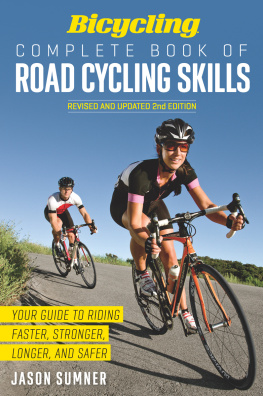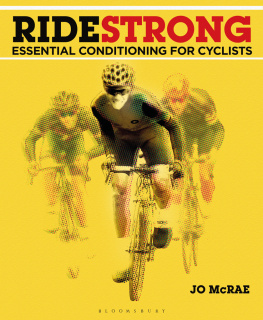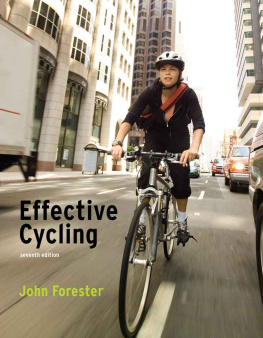Also by Ian Dille:
The Price of Gold (With Marty Nothstein)
Mention of specific companies, organizations, or authorities in this book does not imply endorsement by the author or publisher, nor does mention of specific companies, organizations, or authorities imply that they endorse this book, its author, or the publisher.
Internet addresses and telephone numbers given in this book were accurate at the time it went to press.
2015 by Ian Dille
All rights reserved. No part of this publication may be reproduced or transmitted in any form or by any means, electronic or mechanical, including photocopying, recording, or any other information storage and retrieval system, without the written permission of the publisher.
For information, please write to:
Special Markets Department, Rodale, Inc., 733 Third Avenue, New York, NY 10017
Book design by Rae Ann Spitzenberger
Library of Congress Cataloging-in-Publication Data is on file with the publisher.
ISBN: 9781623364465 hardcover
eISBN: 9781623364472 ebook

We inspire and enable people to improve their lives and the world around them.

Contents
Europe
Prologue
T he bicycle, a human-powered machine of motion. Simple, really. Wheels. Pedals. Handlebars. Go. Through the city. To the park with your kids. Into the countryside, where cows stop chewing grass to look up (seemingly unimpressed), white-tailed deer scamper across the road, and hawks soar overhead, riding the very same wind gusts you do upon your bicycle. Up hills. Up mountains. And down, down, down, down.
Ridden to every end of the earth. Raced on dirt, and grass, and ice, and steeply sloped tracks, and around entire countrieseven continents. Loved and fetishized. Broken up by style and discipline into clubs, and cliques, and cults. Put in museums, and hung from the ceilings of bars. Enshrined in churches. Prayed to.
All of this, not for the machine itself but for the experiences it engenders. Each experience unique to every ride and every rider. But inarguably, some experiences remain more memorable than others. The smell of lavender at a roadside picnic, waiting for the Tour de France to arrive. The vertigo-inducing view of the Pacific Ocean from the 10,000-foot summit of Hawaiis Haleakala volcanic crater (a 5-plus-hour climb). A crisp, pale lager hitting your lips after a ride along the canals of Amsterdam, one of the worlds most bike-friendly cities. These are the sights, the smells, and the tastes that every cyclist should experience before they die.
These and a wide range of other must-do and -see rides, races, shops, and shrines, all rooted to a specific location or event, compose The Cyclists Bucket List. This book is an entirely subjective attempt to catalog both the iconic and the little knownthe accessible and aspirationalsensory and emotional experiences that instill in cyclists such passion for the sport. The siren song of roads that wind into the Alps, Dolomites, and Rockies and the death-defying descents deep in the Andes jungle. The unpredictable adventure of a multiday, or multimonth, bicycle tour across Vietnam, Patagonia, or Africa. Bike shops that serve as museums of the sport. Cities where bicycles overrule automobiles. Rides in traditionally uncelebrated places, like the cornfields of rural Iowa and the windswept Texas Panhandle, that draw thousands upon thousands of people. Youll read about these and many more in The Cyclists Bucket List. And hopefully, youll go experience them yourself before you die.
Ian Dille
October 2014
Austin, Texas
Tour dAfrique
EGYPT TO SOUTH AFRICA
W hen Jenn Crake arrived in Egypt in January 2010, she felt prepared to ride her bike from Cairo to Cape Town, South Africa. Shed taken a 6-month leave of absence from her publishing career in Toronto to prepare for and complete the Tour dAfrique and raised money for the entry fee ($14,500, plus another $20,000 for an African charity). Shed visited the head of the Tropical Disease Units clinic at the Toronto General Hospital to receive inoculations against various diseaseshepatitis A and B, typhoid, yellow fever, rabies, and half a dozen other potential maladies. Shed made a list, focusing on both comfort and economy.
Before she loaded her gear aboard the support truck that would follow her across the continent, it would be weighed. Her gear could not total more than 100 pounds. She spent extra money on nice cycling shorts and a comfortable seat (saddle comfort is essential, she had written on her gear checklist), yet she brought only two pairs of pants (which I would wear for a week at a time). She bought a bike, a Kona Jake cyclocross bike, which she downgraded with low-end Shimano Alivio parts (more likely to find replacement parts for in Africa) and equipped with Schwalbe Marathon Plus tires with super-duty flat protection to ward off knifelike thorns. (She got only five flats during her ride across Africa, but another rider on her trip patched a single inner tube 12 times.)
She trained diligently to prepare for the average 120 kilometers she would ride each day but concedes, There is truly no way to prepare your body for 4 consecutive months of riding in Africa. Crake believed she had made every possible preparation, physically and logistically, but she failed to fully anticipate for the mental and emotional components of the trip. For the next 120 days she would be riding her bike more than at any other time in her life. She would sleep in a tent in the middle of some of the worlds most uninhabited, and most inhabited, places. She would come to know complete strangersthe 50 other participants and half a dozen staff members who would also embark on this journey with herbetter than people she had known her entire life.
However, for Crake, the most disquieting, but also exhilarating, part of this ride across the worlds largest continent was the realization that she would come to know herself better than ever before, too. She knew that at the completion of the Tour dAfrique, she might no longer be the same person. Yet, she didnt know exactly who she would be. As she departed from Cairo, literally riding from the shadows of the pyramids out into a flat, brown landscape, the bright sun descending toward the vast Sahara Desert, a thought slowly dawned on her:


















